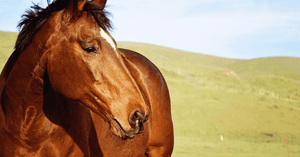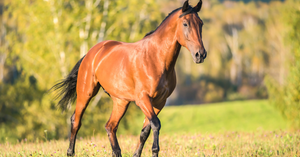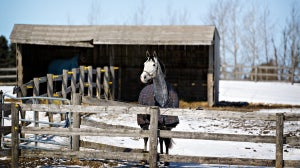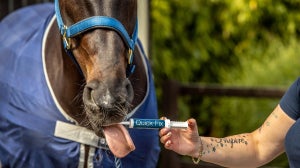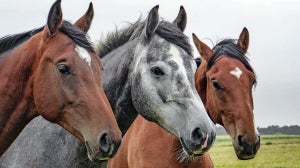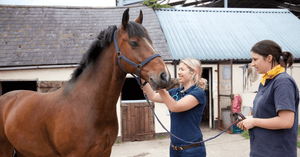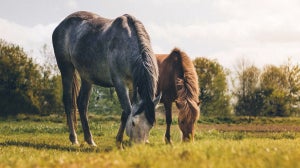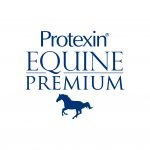
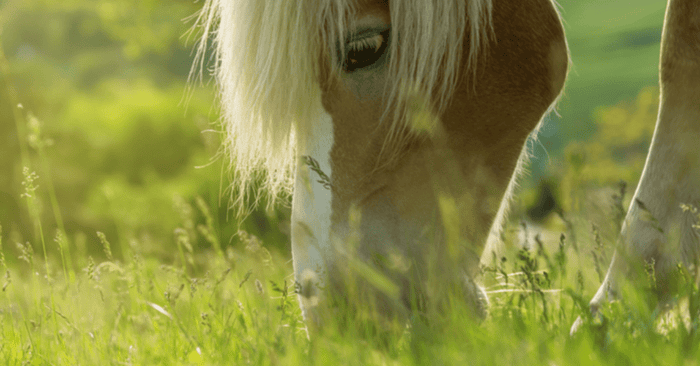
For most horse owners the cold, wet weather and dark mornings and evenings of winter bring additional challenges to their management routine. Here we will discuss a few simple tips and reminders to help keep your horse healthy and your winter stress-free. We will look at how being proactive with healthcare and management strategies can help reduce the risk of problems arising with your equine in the depths of midwinter.
Healthcare:
Vaccination and veterinary ‘MOT’
It can be a sensible idea to have your vet perform a check up on your horse/pony before winter arrives. This way any potential problem with their health can be identified and resolved before it may become a problem down the line. Many health issues can often be exacerbated due to the wintery conditions, so it is better to nip these in the bud before they become a problem. Prevention is better than cure!
Depending on your situation, housing your horse in winter may mean that they have more contact with other horses than before. It is therefore a sensible idea to check your horse is up to date with their Equine Influenza vaccination before coming in for the winter.
Teeth
The oncoming winter can often mean a change in diet of some variety, and this could mean your horse having to chew more and for longer. It is a good idea to have your horse’s teeth checked before the transition to winter, to make sure they are in tip top condition and so can cope with any different feed that is given to them. It is worth arranging for your Vet or qualified Equine Dental Technician (EDT) to check their teeth before you start to transition feeds. This way, any issues can be resolved either by floating (rasping) or other dental treatment and we can avoid quidding, infections and subsequent weight loss.
Worming status
If worms are present they can cause disease in many ways during the winter period. Youngstock with high worm burdens may fail to thrive over winter, and all equines will be at risk of cyathostominosis. This is when small Strongyles (small redworm) effectively bury, or encyst, into the horse’s gut lining to ‘hide’ from the winter. These then emerge from the gut lining and can cause devastating problems. Typically these worms used to emerge in the spring time, but now we are seeing emergence all year round due to climate change and resistance to wormers. It is really worth checking your horse’s worm status before you go into winter, to avoid these issues down the line. Every horse and their management is different, so there is not one simple rule for detection and treatment. Speak to your vet about a bespoke worm strategy. This may involve a combination of the following:
- Faecal egg count - Blood test for encysted redworm - Saliva test for tapeworm
Management:
Turnout
If your horse gets turnout over winter, or fully “winters out” you’ll almost certainly need to supplement the remaining grass with forage. Make sure this hay/haylage doesn’t get wet – it is better to feed smaller quantities daily than to put out larger quantities for the week. Always try to change where you put the hay and do not allow the surrounding ground to become poached.
Beware of cold weather and laminitis! A combination of sunny daytimes and frost at night can increase the starch content of the grass and trigger laminitis in prone horses and ponies. When the days are bright but night time temperatures persist below 5 degrees Celsius it may be worth stabling or grass-restricting your pony until the night-time temperatures increase again, to reduce the risk of a flare-up.
When turned out, wet conditions can cause nasty skin infections like Rain Scald and Mud Fever. Always ensure your horse has shelter from the elements and is appropriately rugged if required (not all will need rugging, especially some ponies).
Make sure that the winter turnout is in the best condition it can be before the weather gets wetter. If drainage is poor and the ground is already damaged then it will be more liable to flooding and poaching. Also make sure all fences have been well maintained and are safe.
Stabling
Start preparations early. Begin stabling your horse for short periods, or overnight, early in the autumn to avoid going from full turnout to stabling abruptly.
Either by poor design or to keep the elements out, many stables suffer from poor ventilation. Dust in the atmosphere can cause chronic coughs, allergies and can trigger Equine Asthma (previously called RAO/COPD). A build-up of dust and cobwebs in the rafters of your stable can often be a tell-tale sign that the ventilation may not be appropriate. Sometimes you can ‘feel’ the dustiness and lack of airflow when you walk into a stable – your horse will be experiencing this too! To reduce dust in your stable switch to dust free bedding, rinse forage before feeding, and choose outward-facing boxes or well-designed barns with good airflow.
Some horses take well to stabling, but we all know horses which find being isolated and confined very stressful. Crib biting, wind sucking, weaving and other vices are all too common in stabled horses and can predispose to stomach ulcers, weight loss and other stress-induced conditions. These horses may do better in the field over winter. If that is not an option, it is important to provide companionship and enrichment with treat balls, salt licks and similar objects.
With increased stabling, time spent eating is reduced. Rather than grazing all day horses tend to eat their forage as it is fed – in two meals (normally two haynets). These two ‘boluses’ put more pressure on the intestines during feeding, and the more time spent without food (when they have eaten all their net) increases the risk of stomach ulcers. Remember to try to trickle feed your horse as much as you can, mimicking how they would eat when they are out grazing. This will minimise any possible digestion issues and reduce colic risk.
When your horse is stabled their movement is also reduced. Ambling around the field during grazing may not seem like important exercise, but this movement helps with digestion and keeps the joints supple. When stabled for long periods, try to get your horse out and about at least twice each day, whatever the weather! Movement promotes digestion, blood flow, muscle tone and joint health. This can be turnout, walking out, lunging, riding… anything to promote movement and to stimulate them mentally. As degenerative joint disease often worsens with reduced movement (going from walking round a field to stabling all day) and with cold, damp weather. Please contact your vet to discuss this further. Degenerative joint disease often worsens with reduced movement (going from walking round a field to stabling all day) and with cold, damp weather. Your vet will be able to discuss this further.
Provide clean fresh water daily and monitor drinking.
Feeding
When transitioning from grass to hay/haylage, introduce this forage gradually, either during stabling or add it to the pasture. Transitioning slowly allows the gut microbes to adjust, promoting proper digestion. This helps avoid issues such as spasmodic colic and impaction colic.
Many owners will turn to high energy hard feeds to keep condition on their horses during the colder months. However, the majority of horses can gain enough energy from forage alone, without the need for hard feed. So unless you are frequently training, competing or hunting for most of the winter, then it is likely your horse or pony will not need more than good quality hay/haylage and perhaps a low calorie vitamin and mineral balancer. If really needed, low starch hard feed and oil can provide safe additional calories if required.
Remember that it’s perfectly natural for your horse to lose some weight over the winter. It can be beneficial to reduce their body condition slightly before the spring grass arrives - especially those which are prone to laminitis or Equine Metabolic Syndrome (EMS). If in doubt, think of the horses out on the grassy plains thousands of years ago! Plan ahead to reduce problems in the spring and if you are unsure then contact your vet for advice.
Good planning and proper attention to healthcare, feeding and management practices will help keep your horse healthy this winter. By preparing for any potential issues well in advance, your horse will be more capable of dealing with anything the winter may throw at them, and so will be happier and healthier throughout this often difficult time. Being prepared may end up saving you time and money in the long run too!


